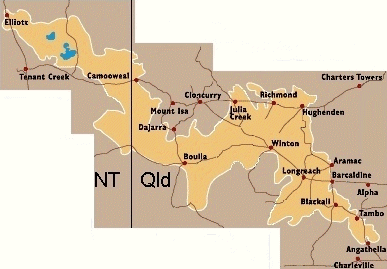This morning we set off soon after breakfast to the Australian Stockman'’ Hall of Fame, one of the other must-sees in Longreach. This and the Qantas Museum have set us back nearly $100 and this is after Chris’s oldies card being produced, however worth every cent. The fact is, of course, that these are not state repositories of treasure but private businesses and need to make a profit or at least cover their costs unlike government funded places.
It was
obvious right from the start that this was a very professional operation. It
really is an excellent museum and we ended up spending about four and a half hours there, not counting the
time we spent popping back to camp for lunch.
I was
very impressed with the section that relates to the first explorers of the
country; story boards and an interactive map which lights up showing the routes
taken. Perhaps this was so much more relevant because I am almost finished
reading Sarah Murgatroyd’s The Dig Tree.
I did read this soon after arriving here in Australia, in a Readers Digest
condensed form. The full extended version is quite marvellous and I highly recommend
it. This is one book which will find itself back in my New Zealand library even
if I have to carry it back in my handbag.
Here at
the museum, there are numerous story boards all around the walls of the museum
commemorating the “Unsung Heroes” of
the outback and there were some absolute gems amongs these biopics, such as:
“Donkeys were used extensively throughout
Australia pulling wagons. They were never hand fed, as they were able to forage
enough food from the surrounding country. Usually a saddle horse accompanied
each team and it was used to muster the donkeys in the morning. Donkey teams
covered between 12 and 15 kilometers per day. Foals born during the trip
were often too weak to keep up with the team so they were put in a wheat bag,
hung under the wagon and emptied out each night to find their mother.” My emphasis. That
last part is so very cute!
Another referred to “open season for oppossums 1927 and 1929”. This was interesting
because here in Australia possums are protected whereas in New Zealand, every day
is open season on Australian possums.
There is
a comprehensive section on stock droving and the historic stock routes that
criss-cross the continent. I was particularly interested to learn about the
Canning Stock Route which snakes more than 1,400 kilometres across four of
Australia’s most remote deserts in the western half of the continent. Only
thirty one mobs were taken down the route over the entire fifty three year
history, due to its lack of water, hostile aboriginals and intense heat. It is
one of those travel routes that 4WDers will sometimes speak whistfully of, an
experience that sounds tempting but must obviously be left in that dream space
rather than reality.
Still on
the subject of droving, it was interesting to learn that such a project in
those bygone days would require a vehicle, today motorised veheicles, but in
days gone by, a wagon, which would be loaded up with up to three tons of gear
including belongings of perhaps twelve men and their rations, as well as
general equipment and usually a 500 gallon water tank. More than 100 horses
might accompany the gear including several relief teams for the wagon. Each
ringer needed five to six day horses as well as one night horse. It was usual
to use one horse for every half day shift every third day. A good night horse
with accurate night vision was essential to prevent the mob of cattle rushing.
A
section of the museum spells out the beginning and operation of the Flying
Doctor Service started by the Reverend Flynn. We had learned all about this and
the radio communication development when we passed through Cloncurry in 2011,
so it was a case of déjà vu.
Everything
related to station life, and all support services and working life are
represented here in the museum and should not be missed as one passes through Longreach.
If necessary, just don’t eat for a day; fuel is more important. Speaking
of which, we topped up with fuel, yet again, now paying $1.579 per litre in
this part of the world.

No comments:
Post a Comment